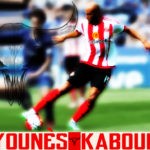
We started our season at Leicester with a line up that included Seb Coates and Costel Pantsilimon. Substitutes included Adam Matthews, who came on for Billy Jones.
By the time we got to the final game Seb Coates, Costel Pantsilimon and Adam Matthews were no longer at the club. Billy Jones, subbed 12 games previously and subsequently dropped, came on for the final fifteen minutes, replacing DeAndré Yedlin, who hadn’t featured at Leicester.
They weren’t the only changes. Our manager had long gone, as had Danny Graham, Stephen Fletcher, Emanuelle Giaccherini, and Liam Bridcutt, all subs for that first game. Our new manager had made room for players who could bolster a leaky defence and strengthen a porous midfield.
They were Lamine Kone, Whabi Khazri and Jan Kirchoff.
And the rest is history
It wasn’t straightforward. Sam Allardyce, appointed in October, had to identify the strengths and weakness in his existing players in order to get points on board before the transfer window opened. He had to decide who should stay, who should go, and who should come. And once the transfer window shut he had to meld his players into a winning team.
He did it, but with little room to spare, and until he reached the optimal combination there was change after change, up front, in midfield and in the back line, which is where we find ourselves in this post:
The full back pairing of Van Aanholt and Jones which started the season lasted seven games before Yedlin got his chance, with Patrick van Aanholt making way for the loanee. The Jones/Yedlin combination lasted some seven games before Big Sam began to make changes, during which the three played together in a 6-2 loss at Goodison.
After that loss the three never played together again; from then until the final game at Watford only two of the three played in any game. Sam first settled on PVA and Jones, who went into the New Year looking as if they would go to the end of the season. It wasn’t to be. A disastrous 10 minutes for Billy Jones at Anfield saw him subbed for Yedlin and he never regained the ascendancy. Yedlin played in the next game – a win against Man Utd – and was first choice for the rest of the season.
Was Sam right to decide on that combination?
| Games | Won | Drawn | Lost | %pts won | ||
| Van Aanholt /Jones | 17 | 3 | 4 | 10 | 25 | |
| Van Aanholt /Yedlin | 14 | 5 | 6 | 3 | 50 | |
| Yedlin / Jones | 5 | 1 | 1 | 3 | 27 | |
As two of the three played in almost every game we should be able to compare pairings. However, the Yedlin/Jones combination appeared much less frequently than the others, which isn’t good for reliability. Maybe Sam had seen enough.
When Jones played alongside van Aanholt or Yedlin the team gained about a quarter of the points they contested and wins were sparse. When Jones didn’t play wins came more frequently and twice as many points were gained.
The stats suggest Sam was right but before reaching your conclusion you need to bear in mind that the midfield and centre backs also changed and that had an effect on the whole team.
And how those centre backs changed:
Younes Kaboul made his debut at Leicester on the opening day. He didn’t play in the final game at Watford. It wasn’t that he’d gone, he just wasn’t needed in that game. John O’Shea was given an outing before he went off to the Euros and, as he had done throughout the season, he did his bit.
For me, O’Shea played a key role in our survival. In the early part he helped Kaboul, and also Coates. In the later part of the season, coming on as a sub, he steadied the ship and saw us hold on to wins and draws when it mattered. Over the season, including games where he appeared as sub, O’Shea played in at least six combinations and when he wasn’t there the team suffered.
We lost just about every game when O’Shea didn’t make an appearance. Coates and Kaboul had poor results working as a pair, nor did Coates and an aging Wes Brown achieve solidity. But when John O’Shea joined them there were better results and we got some much needed wins on board. O’Shea didn’t just play the ball, he talked and organised, he made his experience tell.
| Games | Won | Drawn | lost | %pt.s | |
| Kone/Kaboul/Kirchoff* | 11 | 3 | 7 | 1 | 48 |
| Coates/O’Shea | 5 | 1 | 2 | 2 | 33 |
| O’Shea/Kaboul/Coates | 5 | 3 | 0 | 2 | 60 |
| Coates/Kaboul | 4 | 0 | 0 | 4 | 0 |
| O’Shea/Kone/Kirchhoff | 4 | 1 | 1 | 2 | 33 |
| O’Shea/Kaboul | 3 | 0 | 1 | 2 | 11 |
| Coates/Brown | 2 | 0 | 0 | 2 | 0 |
| Coates/O’Shea/Brown | 1 | 1 | 0 | 0 | 100% |
*plus O’Shea [and Seb and Catts] as sub
With Coates’ departure and the arrival of Kone and Kirchoff Sam made changes which benefited both midfield and the back line. Kirchoff slotted in in between and made the pitch his own, breaking up opposition moves and getting the ball forward. He made life easier for Kone and Kaboul, who went on to form an excellent partnership, and the trio worked together to give our defence a spine. John O’Shea found himself on the bench.
However, Kirchoff, especially, seemed to take a while to adjust to the tempo of the premiership and the three rarely completed 90 minutes together.

John O’Shea was one of the players who could come on to see a game out and he replaced not only Kirchoff, but also Koné and Kaboul in games where we gained points. He even replaced Cattermole to ensure the win against Everton that secured our safety.
Fans may rightly praise Kirchoff, Koné and Kaboul for their resilience in the run in; they were our best defensive combination. But fans should also give thanks that we had O’Shea, not only in the run in but throughout the season. He made an immense contribution from start to finish and he had a part in all nine of our wins.
Here’s a summary of the defensive combinations and points gained as the season progressed. (My apologies to anyone with red-green colour blindness, I couldn’t find a better colour scheme as I tweaked and resized the diagram to make a picture that would fit. And I never did quite manage to get the top and bottom to line up on a web page.) The green/yellow/red line at the top represents w/d/l; brown blocks represent appearances as a sub or sometimes (as with Billy Jones) less than 90 minutes on the pitch. Not all substitutions, especially some short appearances, are shown:

Looking at the big picture, we appear to get most points with PVA and Yedlin playing, whoever the centre backs are. The effect of Koné, Kaboul and and Kirchoff can be seen in the rise of the blue line (showing league points) in the latter part of the season. But look down from the green bars in the middle. O’Shea was there.
He was always there, no matter who was beside him. That’s the player he is.
But O’Shea is now 35, and no-one goes on forever. It’s right and proper that he should take a step back. It worked last season and it should work in the season to come, provided we maintain our squad. With that in mind, and with the transfer window about to open, I leave you with what my somewhat dodgy numbers say would be our strongest defence:
| All player graphics | by Jake | ||
I wonder what resemblance it will bear to the team that walks out at The Etihad Stadium in August.
This is the third and final installment of my player analysis. The stats I used came from the statcat; hosted stats.com, Squawka.com and SAFC’s website and I threw in a few sums of my own. For the first part of the analysis, (midfield) click here. For the second part (individual defenders) click here.
Over 2,000 votes have been cast in our relegation poll, which will close with the opening of the transfer window. Every Premiership club has had votes cast for it and my next task will be to sumarise the results and draw up a shortlist of clubs to go through to the next round. (It’s a bit like the Euros, only fewer sides go through). The poll will close around the time the transfer window opens so there’s still time to vote if you haven’t already done so. If you want to have your say click here.




